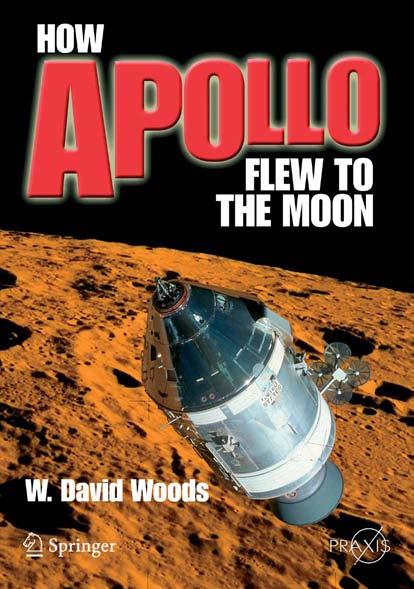How Apollo Flew to the Moon by W. David Woods

Author:W. David Woods
Language: eng
Format: mobi, epub, pdf
Tags: Technology & Engineering, Space Flight - History, Space Flight to the Moon, Electronic Books, Science, Project Apollo (U.S.), Astronautics, Astrophysics & Space Science, United States - History, Project Apollo (U.S.) - History, Astronomy, Space Flight, Aeronautics & Astronautics, History
ISBN: 9780387716756
Publisher: Springer
Published: 2008-01-02T00:00:00+00:00
SPS: the engine that just had to work
The SPS engine was mounted at the rear of the central tunnel, below the helium tanks. This was the one major engine in the Apollo system that had to be capable of being regularly restarted from the point of view of crew safety. Failure to operate at its first major firing to enter lunar orbit could be tolerated, because the spacecraft would loop behind the Moon and return to Earth's vicinity. Other engines could then restore a trajectory home. However, a spacecraft already in lunar orbit was completely dependent on the successful restarting of that engine to bring the crew home.
With maximum reliability in mind, engineers endowed the engine with two of just about everything: two control systems, two sets of plumbing, two ways to pressurise the propellant tanks. In fact, except for the rather passive combustion chamber and bell, and the injector plate, the SPS engine was really two engines in one, with the crew having entirely separate control of either. Even pumps were banished from its systems in order to avoid having to rely on the moving parts that they contained. Instead, helium gas provided the pressure needed to push the propellants through the piping and into the combustion chamber with sufficient force. This helium was stored at extremely high pressure and passed through regulators which reduced its pressure to that required by the large propellant tanks.
Reliability was further assured by the use of a hypergolic fuel and oxidiser combination. This meant that these substances - hydrazine as a fuel and nitrogen tetroxide as an oxidiser - merely had to mix to spontaneously ignite, unlike the engines on the Saturn V's three stages which required igniters to begin their conflagration. On the Apollo stack, every engine within the two spacecraft used these propellants. To start the SPS engine, one had only to open valves and permit these exotic propellants to spray into the combustion chamber through hundreds of holes across the face of the injector. As they met, they burned fiercely, generating an almost invisible but powerful flame. The engine valves could be operated manually by the crew via two prominent switches on their main console, or the computer could send a signal to achieve an automatic burn based on preloaded information and the results of its computations. Having been designed to operate in response to a wide range of command sources, sometimes, when faults afflicted its control systems, care had to be taken to ensure that it would not fire inadvertently.
Soon after the crew of Apollo 15 had extracted their LM and were about to settle into their long coast to the Moon, its commander David Scott reported to mission control: "Okay; that all went fairly nominally, and the only different thing we've noticed is the SPS Thrust light is now on. And we don't know when it came on; somewhere in the process here." This light was meant to indicate that the SPS engine valves were open and that the engine ought therefore to be firing.
Download
How Apollo Flew to the Moon by W. David Woods.epub
How Apollo Flew to the Moon by W. David Woods.pdf
This site does not store any files on its server. We only index and link to content provided by other sites. Please contact the content providers to delete copyright contents if any and email us, we'll remove relevant links or contents immediately.
| Aerodynamics | Aircraft Design & Construction |
| Astronautics & Space Flight | Avionics |
| Gas Dynamics | Propulsion Technology |
Whiskies Galore by Ian Buxton(41935)
Introduction to Aircraft Design (Cambridge Aerospace Series) by John P. Fielding(33085)
Small Unmanned Fixed-wing Aircraft Design by Andrew J. Keane Andras Sobester James P. Scanlan & András Sóbester & James P. Scanlan(32763)
Craft Beer for the Homebrewer by Michael Agnew(18194)
Turbulence by E. J. Noyes(7977)
The Complete Stick Figure Physics Tutorials by Allen Sarah(7334)
Kaplan MCAT General Chemistry Review by Kaplan(6896)
The Thirst by Nesbo Jo(6876)
Bad Blood by John Carreyrou(6580)
Modelling of Convective Heat and Mass Transfer in Rotating Flows by Igor V. Shevchuk(6406)
Learning SQL by Alan Beaulieu(6235)
Weapons of Math Destruction by Cathy O'Neil(6205)
Man-made Catastrophes and Risk Information Concealment by Dmitry Chernov & Didier Sornette(5951)
Digital Minimalism by Cal Newport;(5698)
Life 3.0: Being Human in the Age of Artificial Intelligence by Tegmark Max(5506)
iGen by Jean M. Twenge(5384)
Secrets of Antigravity Propulsion: Tesla, UFOs, and Classified Aerospace Technology by Ph.D. Paul A. Laviolette(5330)
Design of Trajectory Optimization Approach for Space Maneuver Vehicle Skip Entry Problems by Runqi Chai & Al Savvaris & Antonios Tsourdos & Senchun Chai(5036)
Pale Blue Dot by Carl Sagan(4949)
